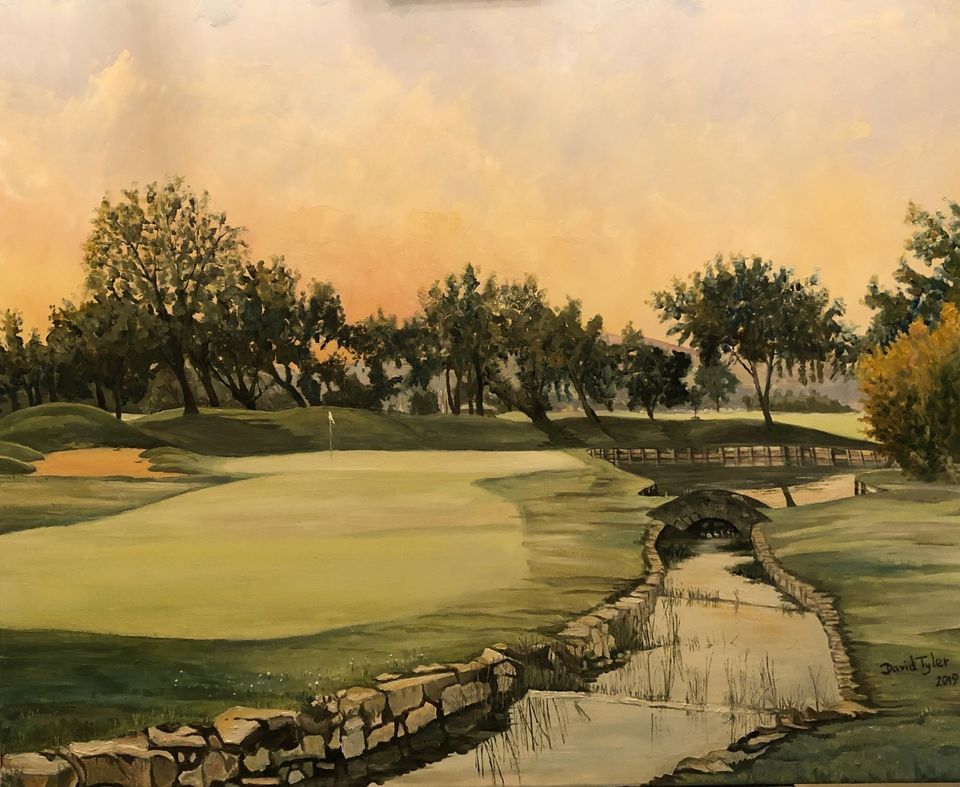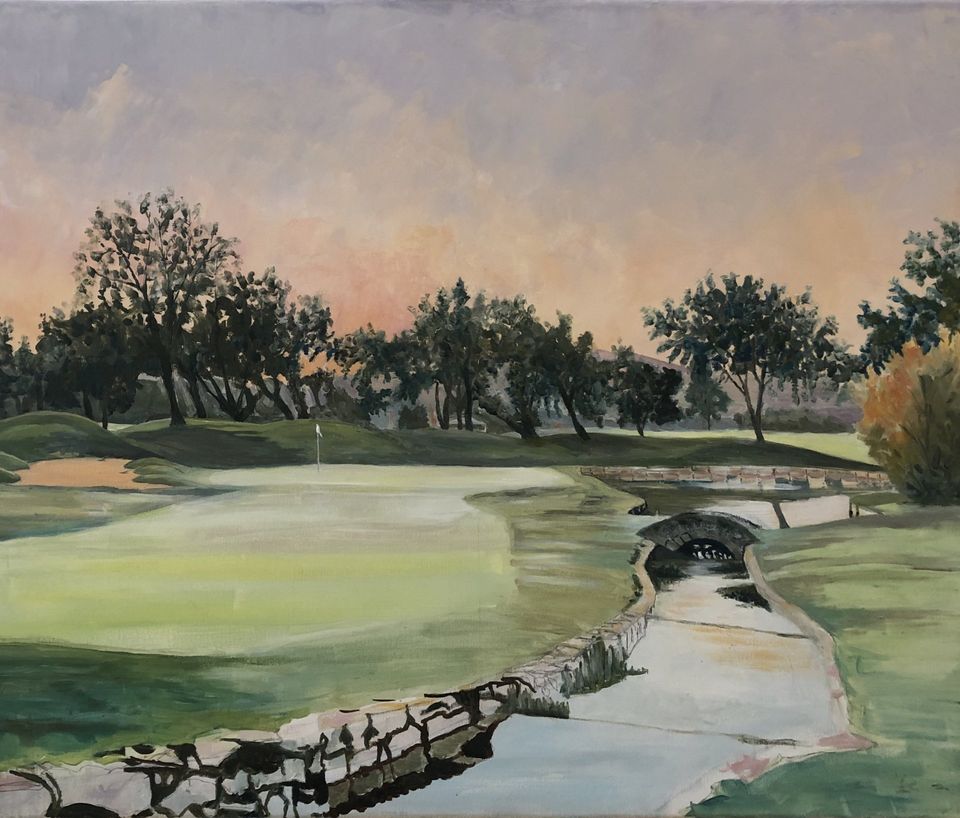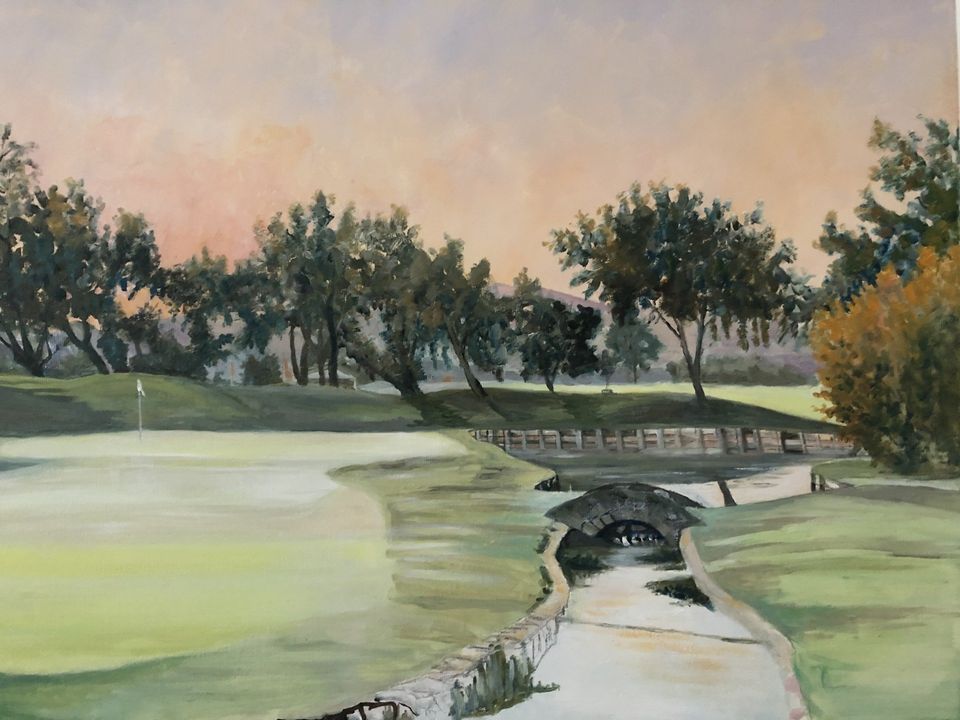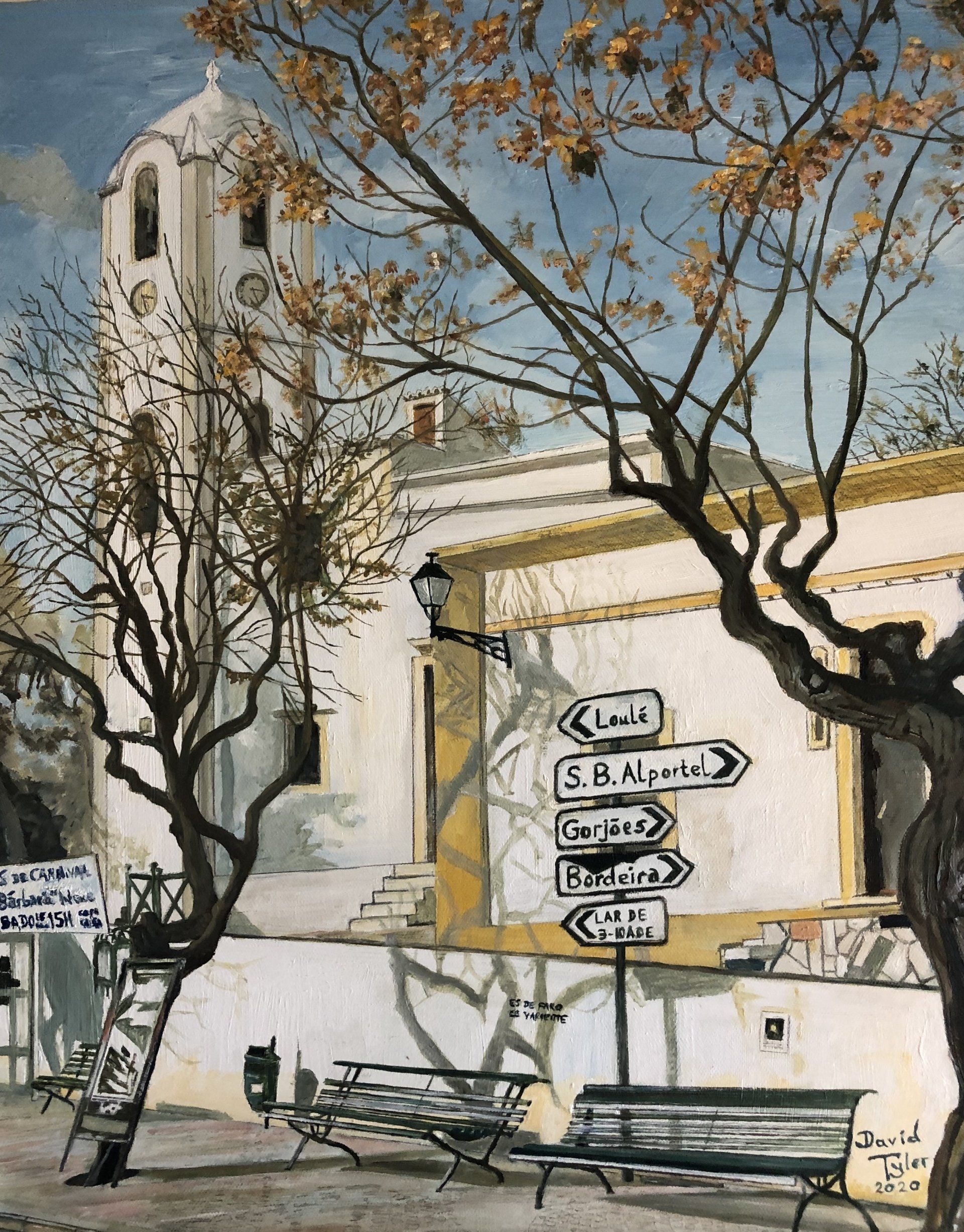Blog Layout
The 18th hole, San Roque Old Course, in evening light, December 2019
3 December 2019
There is a golfing theme to my December 2019 offering. It is an exciting time at The San Roque Club. The Old Course closed on November 3 for an extensive 12-month refurbishment with the installation of a new irrigation system and significant changes to several holes. Also, the order of the two nines will be switched when the Old Course re-opens, so the eighteenth signature hole, with its water hazards, will become the ninth. My painting attempts to depict this famous dog-leg par 4, with water left off the tee, bunkers down the right, a stream to cross on the approach to the large, long green, and not forgetting a dangerous pond to the right of the putting surface, which will capture any errant shot. bordered on the right by a large pond. It’s a classic risk reward creation, by original course architect Dave Thomas. Apologies to non-golfers, but for those interested, it plays 428 yards from the back tees and an equally challenging 346 yards from the red tee markers.
Step 1:
I started with a canvas block 73cm wide by 60cm high and drew in some rough outlines to get the basic composition as I wanted it. The next task was to block in some colour to delineate the main areas of the painting. I used a mixture of Sahara Yellow, Magenta and Titanium White with traces of Prussian Blue and Phthalo Blue for the evening sky. These colours were picked up in the small lake on the right. The mountains in the distance were rendered in two tones of a faint grey purple mixed from Titanium White, Magenta, Prussian Blue and Burnt Umber. I put light blue and grey tones down in the area of the stream which cuts across the fairway. The bunker left of the green is catching the light and required Sahara Yellow and Magenta tempered by a bit of Titanium White. Next, I put in the mounding around the putting surface to the left and rear using Lemon Yellow, Phthalo Blue, Burnt Umber, Raw Sienna and Titanium White mixed in various different combinations. The putting surface is a mix of Lemon Yellow and Titanium White as is the distant fairway in the distance behind the mounding. The latter has more yellow. I put in some of the trees to help set up contrast. Raw Sienna was used for the base colour to mark the position of the large bushy tree on the far right. The trees in the distance were put in with Burnt Umber tempered by various mid-range greens. This stage was completed by putting in a light wash of pale greens with a high component of Lemon Yellow well thinned down to mark out the fairway. The areas of rough were suggested by a base colour of mid to dark greens with the more vibrant colour closer to the foreground to help set up perspective.
Step 2:
The main task here was to put in the trees which are behind the putting surface, along the top of the mounding, or beyond it. I also developed the two bushy trees which are closer, but on the far right of the painting. To get a realistic leaf effect it is helpful to layer the leaves in two or three different sittings. Then I worked on the little stone foot-bridge which is a charming feature in front of the small lake. Colours used for the trees were Phthalo Blue, Sahara Yellow, Lemon Yellow, Burnt Umber and Chinese White with the addition of extra Sahara Yellow and traces of Magenta where the light is catching the bushy tree on the right. The bridge was rendered in a mix of greys, white and mossy green with Burnt Umber and Prussian Blue used for shadows. I retouched the sky in a few places where necessary using a mix of Titanium White, Sahara Yellow and Magenta to keep the light peach pink colour required. Some more definition to the edges of the water feature and a base for the reflections in the small lake on the right have also been added.
Step 3:
I put in the flag to the left centre of the putting surface as a focal point. The next step was to refine the mounding around the bunker to the left and add a few highlights to the bunker sand. A suggestion of the two rakes was also added as part of this process. Then I turned my attention to the water to the right of the green, putting in reflections of the trees and mounding. The far side of this small lake has wooden planking and I have attempted to suggest the structure of this with Burnt Umber, Raw Sienna, Titanium White and traces of Prussian Blue and Sahara Yellow. It was time consuming to get this looking right! More detail was added to the stone bridge in front of the lake.
Step 4:
This phase centred around putting in the stonework either side of the stream with a hint of the descending levels of the water, the reflections and the grasses and weed growing up along this watercourse.
Step 5:
Now I turned my attention to the light rough in the foreground either side of the stream rendering more detail of the grasses with a few hints of the small white flowers to the left of the stream, possibly daisies growing in the rough. Then I added a bit more detail to the trees on the far right and to the tall one on the left in the distance beyond the bunker. More shadow and texture on the stonework completed this phase.
Step 6:
Finishing touches – a hint of a few buildings in the far distance, some tweaks to the trees and bushes in the distance to ensure correct tonal recession, and a few adjustments to convey slight shadows and folds in the ground. A bit of brilliant white on the flag to enhance the focal point. Stand back and avoid any further fiddling! Re-visit in a couple of days’ time to see if any final tweaks are needed. Allow oil paint to completely dry. Apply matt varnish.
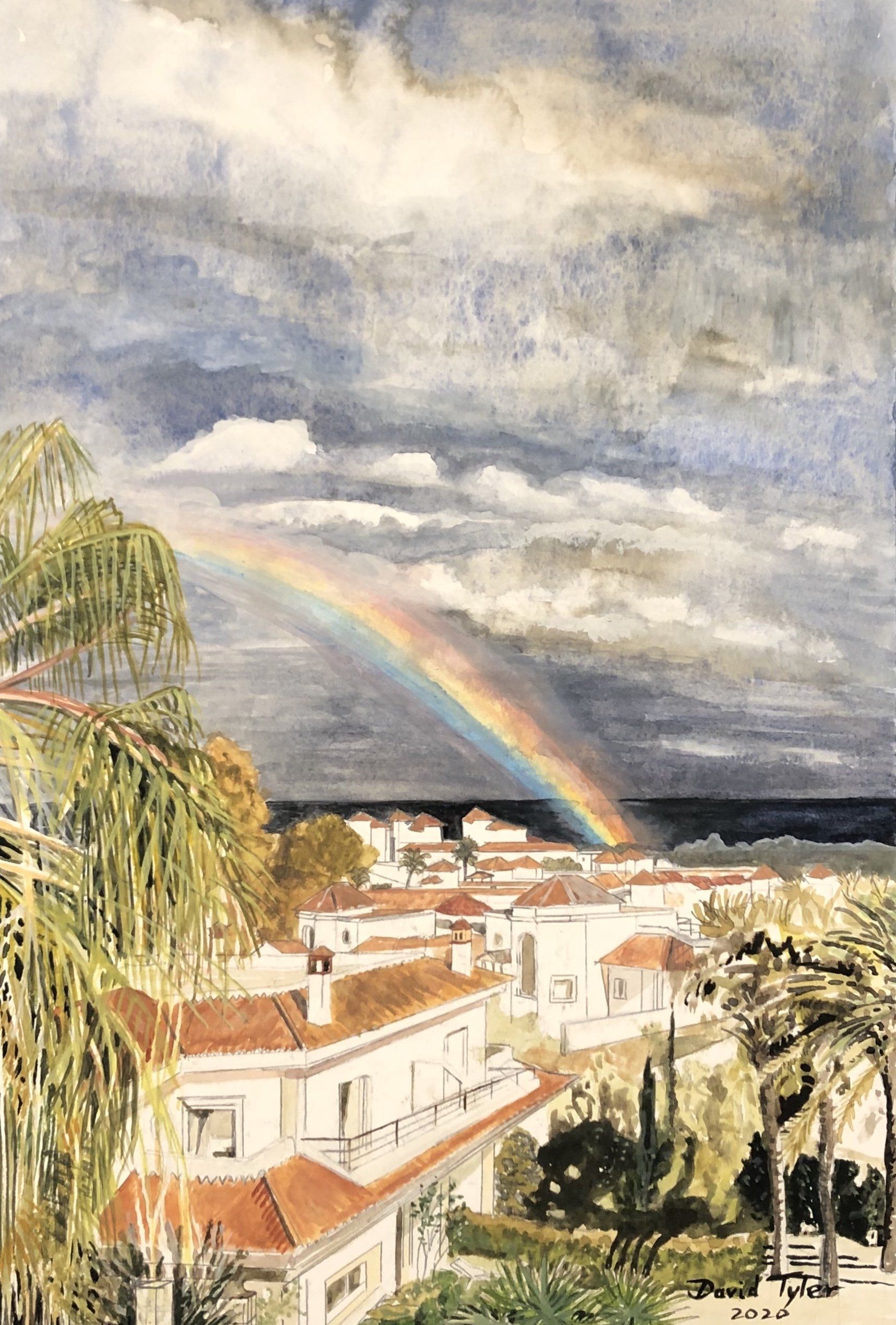
by David Tyler
•
31 May 2020
Esta es la acuarela terminada con el arcoíris, la palmera a la izquierda y los edificios terminados. La canción 'Búscame en Rainbows', cantada por Vicki Brown, ahora tiene un lugar especial en mi corazón, ya que la usamos en el funeral de mi padre el miércoles 13 de mayo de 2020. Esta pintura está dedicada a la memoria de mi padre, Colin Tyler (13 de julio de 1932 - 29 de abril de 2020). Falleció mientras dormía en Merlin Court Care Home en Wiltshire contrayendo neumonía y Covid-19. Fue un gran padre y logró mucho en sus más de 87 años. De una clase trabajadora, obtuvo una beca estatal para Emmanuel College, Cambridge, para leer Derecho. Se convirtió en socio principal de Wragge & Co en Birmingham y fue reconocido como uno de los abogados corporativos más exitosos en el Reino Unido fuera de Londres. Sus cuatro nietos lograron asistir al funeral junto con mi hermano, Richard.

by David Tyler
•
31 May 2020
Etapa uno de esta acuarela que representa una vista tormentosa sobre el Mediterráneo desde nuestro apartamento en The San Roque Club en España durante el bloqueo de Coronavirus. Se usó cinta de enmascarar para proteger el área del arcoíris, la palmera a la izquierda y los edificios a media distancia. Bastante complicado y probablemente más fácil de lograr con el líquido de enmascaramiento.

by David Tyler
•
31 May 2020
This is the finished watercolour with the rainbow, palm tree on the left and buildings completed. The song ‘Look for me in Rainbows’, sung by Vicki Brown, now has a special place in my heart as we used it at my father's funeral on Wednesday 13 May 2020. This painting is dedicated to the memory of my father, Colin Tyler (13 July 1932 - 29 April 2020). He passed away in his sleep at Merlin Court Care Home in Wiltshire having contracted pneumonia and Covid-19. He was a great father and achieved a great deal in his 87 plus years. From a working class background, he got a state scholarship to Emmanuel College, Cambridge, to read Law. He became a senior partner at Wragge & Co in Birmingham and was recognised as one of the most accomplished corporate lawyers in the UK outside of London. His four grandchildren managed to attend the funeral along with my brother, Richard.

by David Tyler
•
31 May 2020
Stage one of this watercolour which depicts a stormy view out over the Mediterranean from our apartment at The San Roque Club in Spain during the Coronavirus lockdown. Masking tape was used to protect the area for the rainbow, the palm tree on the left and the buildings in the middle distance. Quite fiddly to do and probably easier to accomplish with masking fluid.
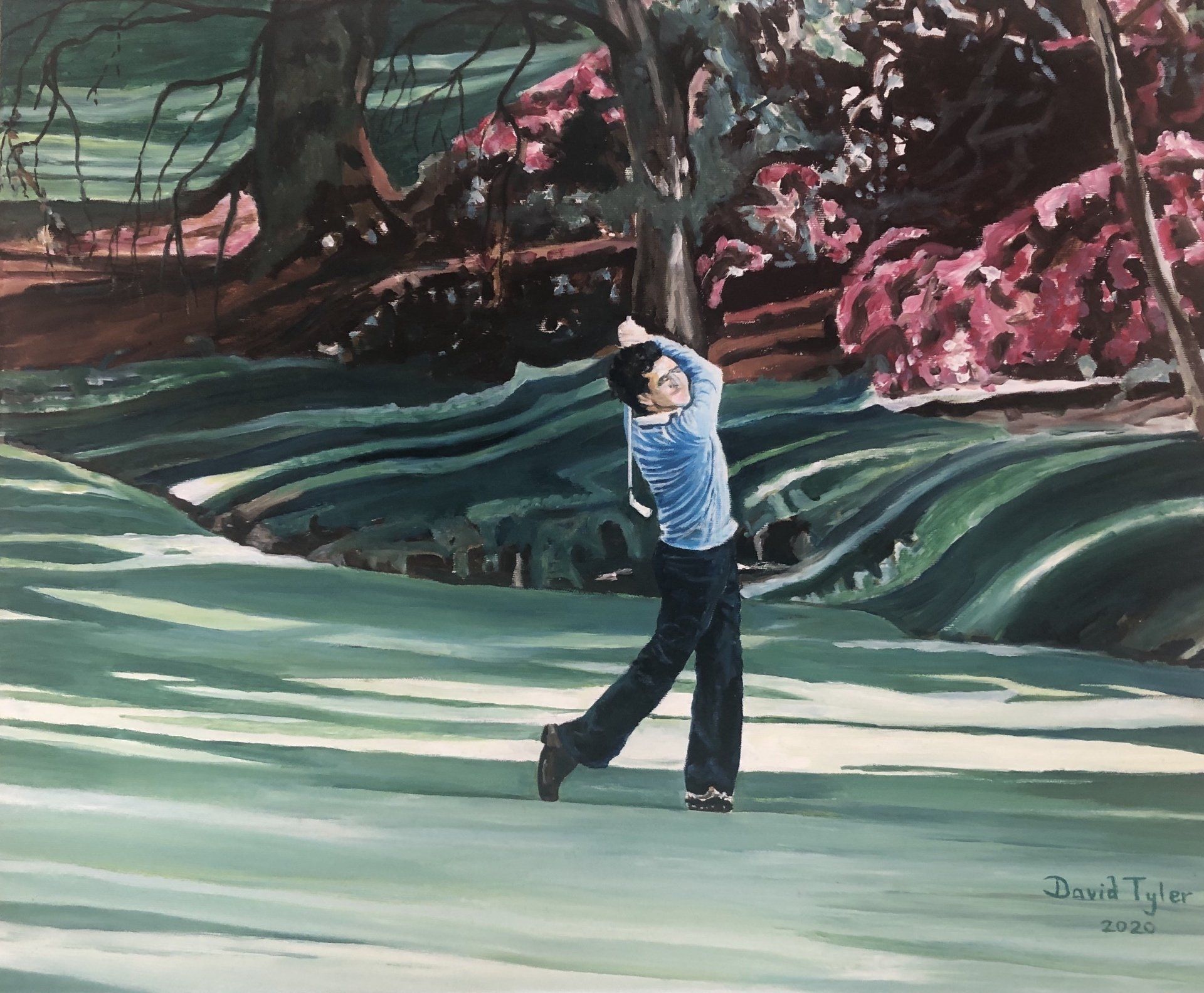
by David Tyler
•
31 May 2020
Seve ganó su segundo título de Masters en Augusta en abril de 1983. Fue su tercer título importante. Terminó cuatro golpes antes de los subcampeones Ben Crenshaw y Tom Kite. El mal tiempo hizo que la ronda final se jugara el lunes 11 de abril de 1983. Seve terminó en -8 con rondas de 68, 70, 73 y 69. El lunes, Seve tuvo un comienzo rápido con un birdie en el primer hoyo, un águila en el segundo, otro birdie en el cuarto hoyo par 3 difícil, seguido de cuatro pares y otro birdie en el noveno, un cinco debajo del par 31 en el frente nueve. Cruzó a la victoria cuando Stadler, Floyd y Watson no lograron llegar a la par y Crenshaw, Kite e Irwin estaban demasiado lejos para montar un desafío decisivo. El hoyo 13 del par 5 de pierna de perro en Augusta es un maravilloso hoyo de riesgo / recompensa con peligro a la izquierda y un arroyo frente al green.

by David Tyler
•
31 May 2020
Seve won his second Masters title at Augusta in April 1983. It was his third major title. He finished four strokes ahead of runners-up Ben Crenshaw and Tom Kite. Bad weather caused the final round to be played on Monday 11 April 1983. Seve finished on -8 with rounds of 68, 70, 73 and 69. On the Monday, Seve got off to a fast start with a birdie on the first hole, an eagle on the second, another birdie on the difficult par 3 fourth hole, followed by four pars and another birdie on the ninth, a five under par 31 on the front nine. He cruised to victory as Stadler, Floyd and Watson failed to break par and Crenshaw, Kite and Irwin were all too far back to mount a decisive challenge. The dog-leg par 5 13th hole at Augusta is a wonderful risk/reward hole with danger down the left and a stream in front of the green.
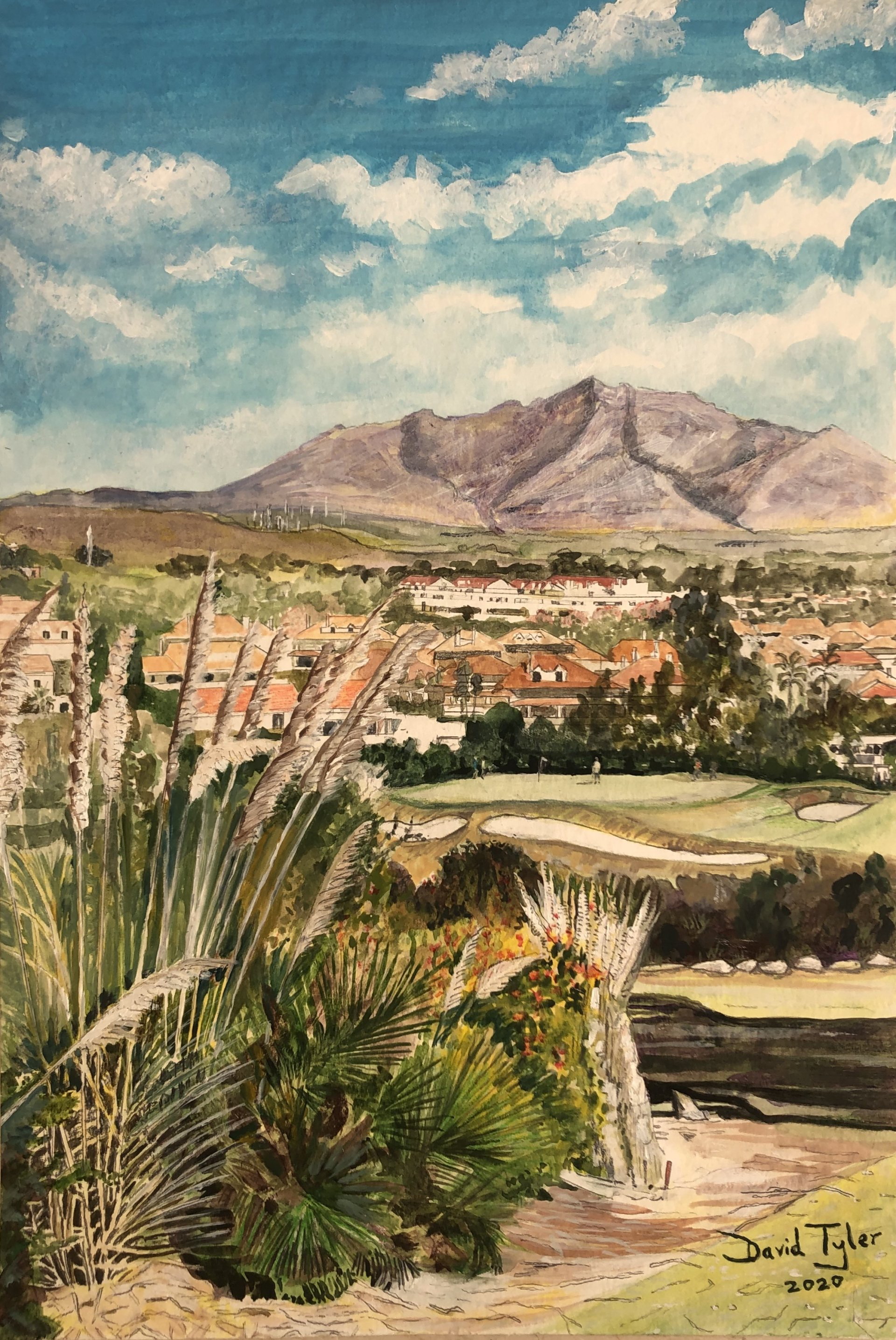
by David Tyler
•
9 March 2020
Este complicado par 3 se juega a través de un profundo barranco arbolado, por lo que cualquier bola que no llegue al green caerá en el búnker de espera, al frente a la izquierda o desaparecerá en la barranca. Hay una zona de caída frente al área de salida delantera. El green está rodeado por siete bunkers, por lo que no es fácil rescatarlo si se equivoca a la derecha. Incluso si encuentra la superficie de juego con su golpe de salida, el par no es simple, ya que el green tiene más de 40 yardas de profundidad y está lleno de ondulaciones. Es muy fácil tres putt. Si no cree que el desafío desde el tee amarillo (179 yardas) o el tee blanco (194 yardas) sea lo suficientemente difícil, siempre está el tee Seve adyacente al tercer green (255 yardas desde el centro del green). Desde aquí tiene una de las mejores vistas del campo de golf.

by David Tyler
•
9 March 2020
This tricky par 3 is played across a deep tree-lined ravine so any ball not reaching the green will drop into the waiting bunker, front left, or disappear into the barranca. There is a dropping zone in front of the forward teeing area. The green is surrounded by seven bunkers so there is no easy bail out if you err to the right. Even if you find the putting surface with your tee shot, par is no simple matter as the green is over 40 yards deep and full of undulations. It is very easy to three putt. If you do not think the challenge from the yellow tee (179 yards) or the white tee (194 yards) is hard enough, there is always the Seve tee adjacent to the third green (255 yards from the middle of the green). From here you have one of the best views on the golf course.




